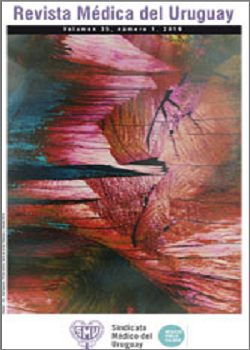Síndrome de Budd-Chiari asociado a síndrome antifosfolípido
Resumen
Introducción:
el síndrome de Budd-Chiari es una entidad rara definida por la obstrucción al flujo de salida venoso hepático. Se asocia frecuentemente a un estado protrombótico. El diagnóstico y tratamiento oportuno representan un reto para el médico clínico. El objetivo del presente trabajo es reportar un caso clínico de síndrome de Budd-Chiari secundario a síndrome antifosfolípido, asociación infrecuente en la literatura.
Caso clínico:
mujer de 31 años. Ascitis de seis años de evolución, actualmente refractaria. Repercusión general en el último año. Examen físico: lúcida, ictericia universal, hepatomegalia dolorosa, esplenomegalia y ascitis a tensión. Laboratorio: hepatograma con patrón colestásico. Colinesterasa y tasa de protrombina descendidas. Ecografía Doppler abdominal: ascitis severa, hepatomegalia irregular, ecogenicidad aumentada. Esplenomegalia. Obstrucción de vena suprahepática media, estrechamiento de vena suprahepática derecha. Flujo escasamente fásico de baja velocidad, invertido en algunas ramas, hepatófugo. Fibrogastroduodenoscopía: várices esofágicas grado III. Se planteó ascitis secundaria a hipertensión portal, probable síndrome de Budd-Chiari. Los anticuerpos IgM beta2 glicoproteína 1 fueron positivos. Diagnóstico de síndrome antifosfolípido. Se realizó trasplante hepático con buena evolución posterior.
Discusión y conclusiones:
el síndrome de Budd-Chiari es más frecuente en mujeres entre los 30 y 50 años. Debe considerarse como causa de enfermedad hepática, fundamentalmente cuando no existe otra causa evidente. Los estados protrombóticos que más se asocian al síndrome de Budd-Chiari en Occidente son las enfermedades hematológicas. El tratamiento debe ser individualizado según la presentación clínica. El trasplante hepático se plantea como medida de salvataje cuando el resto de los tratamientos han fracasado.
Citas
(1) European Association for the Study of the Liver. EASL Clinical Practice Guidelines: vascular diseases of the liver. J Hepatol 2016; 64(1):179-202.
(2) Menon KV, Shah V, Kamath PS. The Budd-Chiari syndrome. N Engl J Med 2004; 350(6):578.
(3) Liu L, Qi XS, Zhao Y, Chen H, Meng XC, Han GH. Budd-Chiari syndrome: current perspectives and controversies. Eur Rev Med Pharmacol Sci 2016; 20(15):3273-81.
(4) Ferral H, Behrens G, Lopera J. Budd-Chiari syndrome. AJR Am J Roentgenol 2012;
(4):737-45.
(5) Valla DC. Primary Budd-Chiari syndrome. J Hepatol 2009; 50(1):195-203.
(6) Buzas C, Sparchez Z, Cucuianu A, Manole S, Lupescu I, Acalovschi M. Budd-Chiari
syndrome secondary to polycythemia vera. A case report. J Gastrointestin Liver Dis 2009; 18(3):363-6.
(7) Aydinli M, Bayraktar Y. Budd-Chiari syndrome: etiology, pathogenesis and diagnosis. World J Gastroenterol 2007; 13(19):2693-6.
(8) Khamashta M. Síndrome antifosfolipídico. En: Farreras P, Rozman C. Medicina Interna. 18ª ed. Barcelona: Elsevier, 2016: 1045-47.
(9) Uthman I, Noureldine MHA, Ruiz-Irastorza G, Khamashta M. Management of antiphospholipid syndrome. Ann Rheum Dis 2018. doi: 10.1136/annrheumdis-2018-213846.
(10) Espinosa G, Font J, García-Pagan JC, Tàssies D, Reverter JC, Gaig C, et al. Budd-Chiari syndrome secondary to antiphospholipid syndrome: clinical and immunologic characteristics of 43 patients. Medicine (Baltimore) 2001; 80(6):345-54.
(11) Iadevaia M, Del Prete A, Cotticelli G, De Sio I, Niglio A, Loguercio C. Budd-Chiari syndrome as a manifestation of antiphospholipid antibody syndrome during oral
contraceptive therapy: more to think about. J Liver 2013; 2:129.
(12) Chinen N, Koyama Y, Sato S, Suzuki Y. A case of acute Budd-Chiari syndrome complicating primary antiphospholipid syndrome presenting as acute abdomen and responding to tight anticoagulant therapy. Case Rep Rheumatol 2016:9565427. doi: 10.1155/2016/9565427.
(13) Sebastiani M, Manzini CU, Campomori F, Spinella A, Vacchi C, Giuggioli D, et al. Unusual association between Budd-Chiari syndrome secondary to antiphospholipid syndrome and relapsing polychondritis: a case report and review of the literature. Clin Rheumatol 2013; 32(6):905-7.
(14) Rand JH, Wolgast LR. Dos and don'ts in diagnosing antiphospholipid syndrome. Hematology Am Soc Hematol Educ Program 2012; 455-9.
(15) Tincani A, Andreoli L, Casu C, Cattaneo R, Meroni P. Antiphospholipid antibody profile: implications for the evaluation and management of patients. Lupus 2010; 19:432-5.
(16) Brusch A. The significance of anti-beta-2-glycoprotein i antibodies in antiphospholipid syndrome. Antibodies 2016; 5(2):16.
(17) Mancuso A. An update on management of Budd-Chiari syndrome. Ann Hepatol 2014; 13(3):323-6.
(18) Solari J, Bandi J, Galdame O, Marciano S, Mullen E, Garcia MR, et al. Diagnóstico, tratamiento y evolución del síndrome de Budd-Chiari: experiencia de un centro. Acta Gastroenterol Latinoam 2010; 40:225-35.
(19) Witte AM, Kool Lj, Veenendaal R, Lamers CB, van Hoek B. Hepatic vein stenting for Budd-Chiari syndrome. Am J Gastroenterol 1997; 92(3):498-501.
(20) Tavill AS, Wood EJ, Kreel L, Jones EA, Gregory M, Sherlock S. The Budd-Chiari syndrome: correlation between hepatic scintigraphy and the clinical, radiological, and pathological findings in nineteen cases of hepatic venous outflow obstruction. Gastroenterology 1975; 68(3):509-18.
(21) Darwish Murad S, Plessier A, Hernandez-Guerra M, Fabris F, Eapen CE, Bahr MJ, et al. Etiology, management, and outcome of the Budd-Chiari syndrome. Ann Intern Med 2009; 151(3):167-75.













